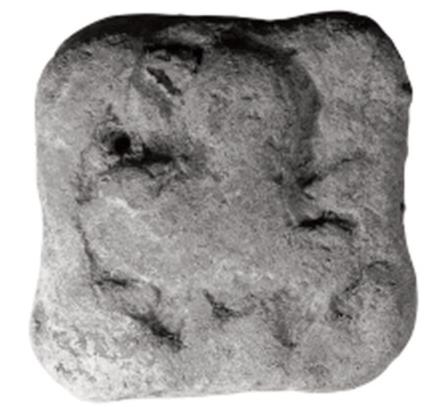
-
Copyright credit: Tekin 2014d

ARCHAEOLOGICAL DESCRIPTION OF THE WEIGHT
Authority
Mint
Lysimachia
Denomination
1/2 Mina
Material
Lead
Manufacture
Cast
Shape
Square
Length
4.60 cm
Width
4.70 cm
Height
1.00 cm
Metrology
| Mass (g) | Mass (grain) | Date of measurement | Reference | fragmented | cleaned | reference weight |
|---|---|---|---|---|---|---|
| 232.50 | - | - | Tekin 2014d | No | No | Yes |
Iconography
| Symbol | Technique | Direction | Position | Number | Synecdoche |
|---|---|---|---|---|---|
| Lion | Relief | RIGHT | Leaping | Protome |
Wear
Corrosion
Handle
No
Suspension hole
No
Recarved mould
No
Recarved weight
No
Intentionally destroyed
No
Archaeological description
Tekin 2014d: This lead weight is square in form with rounded corners and slightly concave edges; it measures 46x47x10 mm and weighs 232.5 g. On the obverse is a lion protome jumping right, with its head turned back, in relief; on the corners, Λ–[Υ]–Σ–Ι and below the belly of the lion, H for ἡμίμναιον (mna of 465 g); all in relief. The reverse is blank.
Tekin 2018: Square lead weight with rounded corners. On the obverse there is a lion protome jumping right, in relief. On the corners, from top left, Λ–Υ–Σ–Ι. Below the belly of the lion is an Η which stands for hemimnaion. The reverse is blank.
Tekin 2018: Square lead weight with rounded corners. On the obverse there is a lion protome jumping right, in relief. On the corners, from top left, Λ–Υ–Σ–Ι. Below the belly of the lion is an Η which stands for hemimnaion. The reverse is blank.
Autopsy
No
INSCRIPTION
| Language | Technique | Legend type |
|---|---|---|
| Greek | Relief | Denomination, Mint |
Fac simile
Λ
Σ Η Ι
Edition
Λ–[υ]|σ–ι(μαχέων) ἡ(μιμναῖον).
Monogram
ARCHAEOLOGICAL CONTEXT
Findspot (region)
Türkiye: Çanakkale
Findspot (site)
Gelibolu [Kallipolis / Kallipoulis]
context
Tekin 2014d: In 2013.
Tekin 2018: Findspot = Bolayır.
Tekin 2018: Findspot = Bolayır.
CIRCUMSTANCES OF ACQUISITION
Region
City
Date of first acquisition
circumstances
DATING OF THE WEIGHT
Curatorial Section
GREEK
Time frame
FROM
-309
TO
-144
Comments on Chronology
Tekin 2014d : The last decade of the 4th century B.C. is the terminus post quem for the earliest Lysimachean weights since the city was founded in about 309 B.C. The deadline for the Lysimachean weights is about mid-2nd century B.C. when Lysimachea was destroyed by the Thracians. But, even though the attacks of the Thracians destroyed the city dramatically, one may think that the city continued its presence for a while; at least the commercial life was not halted entirely. Consequently, it is possible that the Lysimachean weights may have continued to be produced or used in the second half of the 2nd century B.C.
COLLECTION HISTORY
Collection
| Name | Date of acquisition | Inventory number |
|---|---|---|
| Tekirdağ Museum | Dec. 31, 2013 | 8 (tentative) |
Bibliography
| Reference | Page/Column | Reference (number) | Plate / Figure | Comment |
|---|---|---|---|---|
| Tekin 2014d | 146–147 | 8 | 8 | None |
| Tekin 2016a | 60–65, 181–184 | 21 | None | None |
| Tekin 2018a | 104 | 34 | fig. | None |
VARIA